Difference between revisions of "Calgon"
m (Text replace - "== Authority ==" to "== Sources Checked for Data in Record ==") |
|||
| (2 intermediate revisions by the same user not shown) | |||
| Line 2: | Line 2: | ||
== Description == | == Description == | ||
| − | [ | + | [Reckitt, formerly Reckitt Benckiser] A registered trademark for a family of water softening agents originally composed of [[sodium|metaphosphate sodium hexametaphosphate]]. Calgon, first marketed in 1918, was a water soluble white powder that sequestered many hard water minerals, such as [[calcium carbonate]] and [[calcium sulfate]]. In low concentrations, it inhibited corrosion of [[steel]], prevented the formation of scale from water deposits and minimized precipitate formation during dyeing and laundering. Calgon also acted as a [[dispersant]] and, as such, was used with fillers and pigments in paints. It was used in the pretanning process for leathers where it fixed the hides and minimized swelling (in acidic solutions). Calgon was commonly used for laundry, general cleaning, and papermaking. Although Calgon has been useful for removing calcium deposits on archaeological materials, the sequestering of hard minerals may may change the composition of, and thus destabilize, glass, or glazed artifacts. In recent years, Calgon has developed several formulations many of which no longer contains simple phosphates, which are hazardous to the environments. Some examples are: |
- Calgon N:medium chain sodium polyphosphate for high calcium binding | - Calgon N:medium chain sodium polyphosphate for high calcium binding | ||
| Line 14: | Line 14: | ||
sodium hexametaphosphate; SHMP; metaphosphoric acid, hexadosium salt; sodium polyphosphate; sodium salt of polyphosphoric acid; Calfort (It.) | sodium hexametaphosphate; SHMP; metaphosphoric acid, hexadosium salt; sodium polyphosphate; sodium salt of polyphosphoric acid; Calfort (It.) | ||
| − | == | + | == Risks == |
| + | |||
| + | * Phosphates can be detrimental to water ecosystems. | ||
| + | * Calgon Water Softener: [http://www.rbnainfo.com/MSDS//US/CALGON%20Water%20Softener%20-%20Liquid%20-%20EN%20GHS.pdf SDS] | ||
| + | |||
| + | ==Physical and Chemical Properties== | ||
Soluble in water. Insoluble in most organic solvents. | Soluble in water. Insoluble in most organic solvents. | ||
| Line 27: | Line 32: | ||
|- | |- | ||
! scope="row"| Density | ! scope="row"| Density | ||
| − | | 1.25 | + | | 1.25 g/ml |
|} | |} | ||
| − | == | + | ==Resources and Citations== |
| − | + | * Reckitt: [https://www.reckitt.com/brands/calgon/ Calgon] | |
| − | + | * Calgon: [https://www.calgon.co.uk/ Website] | |
| − | |||
| − | |||
| − | |||
| − | |||
* Richard S. Lewis, Richard S. Lewis, ''Hawley's Condensed Chemical Dictionary'', Van Nostrand Reinhold, New York, 10th ed., 1993 | * Richard S. Lewis, Richard S. Lewis, ''Hawley's Condensed Chemical Dictionary'', Van Nostrand Reinhold, New York, 10th ed., 1993 | ||
| Line 44: | Line 45: | ||
* Random House, Random House, ''Webster's Encyclopedic Unabridged Dictionary of the English Language'', Grammercy Book, New York, 1997 | * Random House, Random House, ''Webster's Encyclopedic Unabridged Dictionary of the English Language'', Grammercy Book, New York, 1997 | ||
| − | * | + | * R.Bruce King, ''Encyclopedia of Inorganic Chemistry'', Wiley, CD-Rom version, 1996 |
* R.M.Organ, R.M.Organ, ''Design for Scientific Conservation of Antiquities'', Smithsonian Institution, Washington DC, 1968 | * R.M.Organ, R.M.Organ, ''Design for Scientific Conservation of Antiquities'', Smithsonian Institution, Washington DC, 1968 | ||
| − | * Website | + | * Website: http://www.homesolutionsnews.com/rbdocs/uk/calgon/faqs_page/faqs.html |
| − | |||
| − | |||
[[Category:Materials database]] | [[Category:Materials database]] | ||
Latest revision as of 14:51, 18 May 2022
Description
[Reckitt, formerly Reckitt Benckiser] A registered trademark for a family of water softening agents originally composed of metaphosphate sodium hexametaphosphate. Calgon, first marketed in 1918, was a water soluble white powder that sequestered many hard water minerals, such as Calcium carbonate and Calcium sulfate. In low concentrations, it inhibited corrosion of Steel, prevented the formation of scale from water deposits and minimized precipitate formation during dyeing and laundering. Calgon also acted as a Dispersant and, as such, was used with fillers and pigments in paints. It was used in the pretanning process for leathers where it fixed the hides and minimized swelling (in acidic solutions). Calgon was commonly used for laundry, general cleaning, and papermaking. Although Calgon has been useful for removing calcium deposits on archaeological materials, the sequestering of hard minerals may may change the composition of, and thus destabilize, glass, or glazed artifacts. In recent years, Calgon has developed several formulations many of which no longer contains simple phosphates, which are hazardous to the environments. Some examples are:
- Calgon N:medium chain sodium polyphosphate for high calcium binding
- Calgon 322: long chain sodium polyphosphate for high calcium binding
- Calgon Water Softener: polycarboxylate listed as active ingredient.
Synonyms and Related Terms
sodium hexametaphosphate; SHMP; metaphosphoric acid, hexadosium salt; sodium polyphosphate; sodium salt of polyphosphoric acid; Calfort (It.)
Risks
- Phosphates can be detrimental to water ecosystems.
- Calgon Water Softener: SDS
Physical and Chemical Properties
Soluble in water. Insoluble in most organic solvents.
| Composition | N2O:P2O7 |
|---|---|
| CAS | 68915-31-1 |
| Density | 1.25 g/ml |
Resources and Citations
- Reckitt: Calgon
- Calgon: Website
- Richard S. Lewis, Richard S. Lewis, Hawley's Condensed Chemical Dictionary, Van Nostrand Reinhold, New York, 10th ed., 1993
- Random House, Random House, Webster's Encyclopedic Unabridged Dictionary of the English Language, Grammercy Book, New York, 1997
- R.Bruce King, Encyclopedia of Inorganic Chemistry, Wiley, CD-Rom version, 1996
- R.M.Organ, R.M.Organ, Design for Scientific Conservation of Antiquities, Smithsonian Institution, Washington DC, 1968
